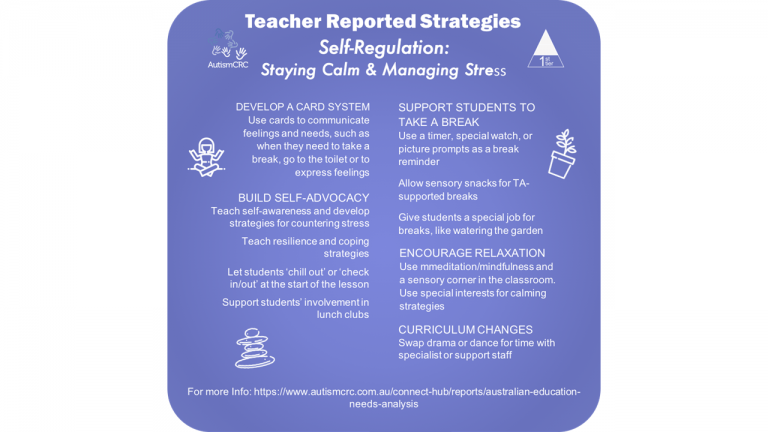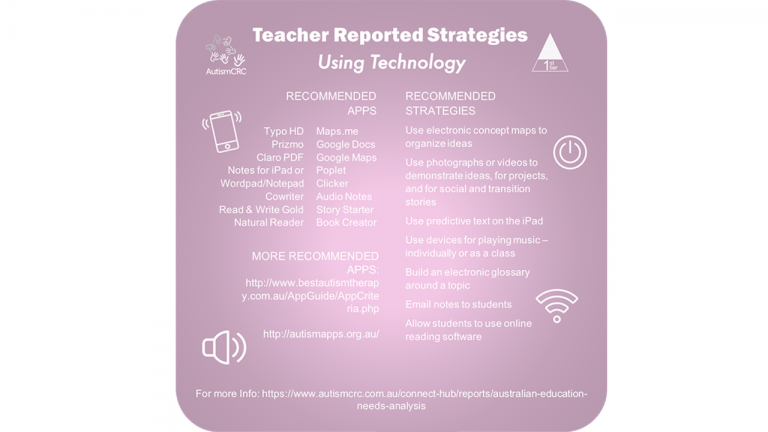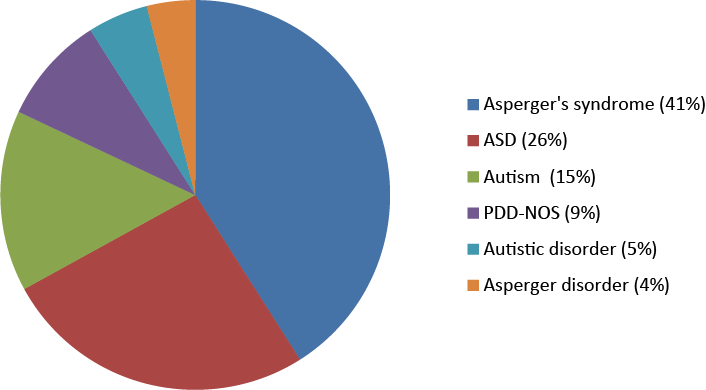
Australian educational needs analysis
Research summary
The Australian Autism Educational Needs Analysis uses a nationwide survey of four key stakeholder groups to identify the educational needs of students on the autism spectrum (ages 5–18) in school settings. The four stakeholder groups consisted of educators, specialists, parents, and students on the spectrum (ages 11–18). This project explores the challenges reported by students on the spectrum and gains insight into strategies and adjustments that they describe as helpful.
Research aim
'I get into trouble all the time at school for things I can’t control [like] talking loud, getting too close to other people, interrupting... I don’t mean to do this stuff, my brain just does it. I hate my brain.'
—Teenage diverse learner
When the needs of students are clearly identified, teachers are able to:
- better understand the needs of diverse learners, including those on the autism spectrum
- understand the perspectives and priorities of parents and students.
Teachers with a greater understanding of students’ needs are better equipped to:
- cater to the diverse needs of all learners
- maximise student engagement and participation in learning environments
- optimise student learning.
In response to the top 10 difficulties described by students, we consulted with 80 expert teachers who identified strategies and adjustments that they have used successfully in Australian classrooms.
Key elements
Students described the difficulties they faced at school:
- planning for assignments
- working as part of a group
- handwriting, in particular being neat
- coping with change, e.g. changes in teachers or the timetable
- coping with bullying or teasing
- handwriting, in particular being quick enough to keep up
- copying information from the board
- doing homework
- staying calm when other kids annoy me or when the classroom is very noisy
- talking in front of the class and starting tasks
Students rated the things that they thought would help them at school:
- being able to use technology to support their educational needs in a variety of ways, e.g. to type or help with school work
- being able to take a break and having time away from others
- being reminded of pending changes
- getting copies of things teachers wrote on the board
- using special interests to do projects
- help with organising themselves
- receiving rewards for jobs well done
- a quiet space to do assessment
- one-on-one help from an adult
Additional qualitative comments from students identified four key themes about things they find most helpful, including:
- empathic, patient teachers
- social support and friendships
- interesting work
- a range of other adjustments, e.g. games, shorter days, quieter classroom, listening to music at school, and professional teachers rather than distance education from home
This project identified 10 key recommendations:
- Educational settings should support the social emotional wellbeing of students on the autism spectrum as an essential element of programming. This has been widely recognised as a protective factor for wellbeing and mental health, as well as a key to educational success.
- Positive behaviour support is vital.
- A flexible and individually tailored educational approach to programming and support for students on the spectrum is critical.
- Educational approaches need to consider student preferences for support including:
- using technology to support academic and learning needs
- one-on-one support inside and outside the classroom
- support for executive function skills, e.g. planning, organisation, and time management skills
- social aspects of schooling, e.g. working as part of a group, getting along with others, and teasing and bullying
- staying calm and being able to access time away when it is needed
- additional support for tasks requiring handwriting
- support for sensory needs support for times of transition or pending change.
- Technology needs to be considered as an essential element of support. A range of technological supports have a place in supporting the needs of students on the spectrum across the whole school day.
- The importance of school connectedness and supporting school connectedness in students on the spectrum has been recognised, and strategies to support and enhance connectedness need to be considered.
- Support for students on the spectrum in educational settings needs to take into consideration the sensory experiences of the environment which may impact on learning, especially noise, touch, and staying still for long periods of time.
- Supporting co-existing conditions experienced by students on the spectrum is essential, especially anxiety, depression, attention difficulties, learning and communication issues, and auditory processing needs. This is particularly important as they move into adolescence.
- Future professional learning for educators and specialists needs to focus on teacher confidence and self-efficacy in supporting students on the spectrum.
- Educator and specialist training needs to be delivered in a variety of ways, including using technology to support learning and development, e.g. face-to-face professional development training, seminars, professional support methods and coaching, and observations of others practice online.
Self-regulation
Self-regulation helps us control our impulses, regulate our behaviour, and stay calm.
Self-regulation is important for social emotional wellbeing, academic success, and social success.
Students on the autism spectrum often experience difficulties with self-regulation and may need explicit and specific teaching of these skills.

Executive function
We use our executive function skills to help us attend to relevant information in the environment.
These skills help us to effectively plan, organise, execute, and sequence tasks in an appropriate time frame. Students use these skills throughout the school day to manage the demands placed on them.
Students on the spectrum may have difficulties with executive function skills, which can affect their ability to manage the demands of the school day.



Supporting transition and impending change
People spend up to one quarter of their days transitioning between tasks.
For students on the spectrum, having to shift attention and a need for 'sameness' can make coping with transition difficult – because transitions require students to deal with new things and can take away from the predictability of the situation.
Supporting change and transition is therefore important for students on the spectrum.

Special interests
Students on the spectrum often have special interests – 'those passions that capture the mind, heart, time, and attention of individuals with ASD, providing a lens through which they view the world' (Winter-Messiers, 2007).
Teachers can help students on the spectrum to participate and engage in learning activities by incorporating students' special interests into learning activities.

Social emotional wellbeing support
Social and emotional wellbeing support is essential to successful inclusion of students on the spectrum.
Effective schools entwine social emotional competence and academic achievement. 'Integrating instructions in both areas maximises students' potential to succeed in school and throughout their lives' (Zins & Elias, 2006).
Responding to the social emotional wellbeing needs of students on the spectrum is critcal to ensuring they can manage the social and emotional aspects of the class and school environment.


Handwriting
While handwriting plays an important role in school and communication, students on the spectrum can find it difficult. They can also find the following tasks challenging:
- being neat
- copying information from the board
- writing at speed for long periods of time
Ensure that handwriting tasks are well-supported for students by:
- considering how essential handwriting is to the task
- providing students with additional support
- allowing students to type
- providing copies of information
- providing a scribe
- using technology apps
- allowing students to take photos of information.

Visual supports
Visual supports are commonly used with students on the spectrum to support learning because they are a resource that, in contrast to auditory information, remains static.
As a result, visual supports can help to:
- increase predictability
- increase comprehension
- increase positive behaviour and participation
- support the shifting of attention
- reduce anxiety.

Technology
'Students on the spectrum have strengths in visual processing that can be promoted through digital tools. They may experience difficulties in communication, complex cues, and affective and social learning that can be supported with digital tools' (Cafiero, 2008).
While a range of digital tools is being rolled out to support these students, the Australian Educational Needs Analysis highlights that technology needs to be supervised and integrated with other approaches, and staff require adequate training in how technology can be used to support the needs of students on the spectrum.

Sensory support
There are seven main sensory systems that gain and process information, including:
- taste
- touch
- hearing
- smell
- visual
- vestibular (balance)
- proprioceptive (position and movement).
The sensory systems of students on the spectrum may be either over-receptive (too sensitive) or under-receptive (not sensitive enough).
As a result, their sensory needs may influence their ability to participate in classroom environments. Consider adjusting the environment to help support students' needs.



Additional information
Listening to and reflecting on the personal experiences of students on the autism spectrum is critically important to developing more inclusive approaches to their education, as well as more effectively supporting their educational needs.
The students in the study rated tasks involving executive function, social and emotional, and fine motor skills as some of the most difficult to manage at school.
Students described helpful strategies in the following key areas:
Self-regulation and social support
- Take a break.
- Have time away from others.
- Support social understanding.
- Build and manage peer relationships.
- Remind students of pending changes.
- Use special interests to do projects.
- Create a quiet space to do assessment.
Executive function
- Remind students of pending changes.
- Give students copies of things teachers wrote on the board.
- Receive rewards for jobs well done.
- Help students with organising themselves.
- Create a quiet space to do assessment.
Subtle, non-stigmatising, one-to-one help from an adult that was responsive to the students’ needs was also highly valued.
Technology to support educational needs in a variety of ways, e.g. to type or help with school work, was another significant support option.
Quick reference guide
Australian Educational Needs Analysis – Diverse learning needs: Quick reference guide
Our evidence base
As part of this project, the survey was completed by specialists, teachers, parents, and students on the autism spectrum, with a particular focus on these students’ perspectives.
- Of the 1468 people who completed the survey, 107 (7.3%) were students on the spectrum, aged 11–18.
- The majority of the students were male.
- The students, aged 11–20 years, had an average age of 15.3 years old.

Students who participated in the needs analysis: What state did they live in?
All states of Australia except the Northern Territory were represented by students who attended schools across a range of different education systems.

Students who participated in the needs analysis: What education sector were they a part of?
Students had received diagnoses of:
- Asperger’s syndrome (41%)
- ASD (26%)
- Autism (15%)
- Pervasive Developmental Disorder—Not Otherwise Specified (PDD-NOS) (9%)
- Autistic disorder (5%)
- Asperger disorder (4%)

Students who participated in the needs analysis: What were their diagnoses?
Students who completed the survey accessed a range of different educational support options. The most common means of support were:
- teacher aide support (52.3%)
- in-class support (41.1%)
- learning support (36.4%)
- a specialist teacher (28.8%)
- social skill support (27.1%)
- student counsellor (26.2%)
Recruitment for the survey was electronically distributed to a range of professional and parent-based national and state organisations.
The student survey could only be accessed through the parent survey. Once anonymous information had been collected from the parent survey, parents were provided with a link to the student survey if they and their child gave consent. The student then completed questions directly related to their educational needs and wellbeing.
Quantitative and qualitative data was collected on a range of topics.
At the completion of the survey, students (ages 11–18) were asked if they would consider being involved in a follow-up semi-structured individual interview. All 10 students interested in being involved were contacted. Students were provided access to the questions prior to the interview and the interview questions were modified for students if required.
Research snapshot
Australian Educational Needs Analysis – Student perspective: Visual snapshot
Meet the researchers

Dr Jill Ashburner

Dr Susan Bruck

Professor Suzanne Carrington

Dr Trevor Clark

Dr Debra Costley

Dr Keely Harper-Hill

David Klug

Associate Professor David Trembath

Dr. Amanda Webster

Dr Beth Saggers
All researcher details including names, honorifics (for example ‘Dr’), and organisational affiliations are correct at the time of the project.
Publications from this project
Saggers, B., Carrington, S.B., & Harper-Hill, K. (2016) The Australian Cooperative Research Centre for Living with Autism (Autism (CRC): Supporting improved educational outcomes for students on the autism spectrum. CAISE Review, 4, pp. 66-85.
Articles informing this project
Australian Advisory Board on Autism Spectrum Disorders. (2012). Education and Autism Spectrum Disorders in Australia: The provision of appropriate educational services for school-age students with Autism Spectrum Disorders in Australia. Position paper (2010) updated 2012. Frenchs Forest: Australian Advisory Board on Autism Spectrum Disorders.
Magyar, C. I., & Pandolfi, V. (2012). Considerations for establishing a multi-tiered problem-solving model for students with autism spectrum disorders and comorbid emotional behavioral disorders. Psychology in the Schools, 49(10), 975–987.
Pellicano, L., Dinsmore, A., & Charman, T., (2014). What should autism research focus upon? Community views and priorities from the United Kingdom. Autism, 18, (7), 756–770. doi:10.1177/1362361314529627.
Ravet, J., (2011). Inclusive/exclusive? Contradictory perspectives on autism and inclusion: The case for an integrative position. International Journal of Inclusive Education, 15(6), 667–682.
Roberts, J., & Simpson, K., (2016) A review of research into stakeholder perspectives on inclusion of students with autism in mainstream schools. Journal of Inclusive Education, 20(10), 1084–1096. doi:10.1080/13603116.2016.1145267
Rodrıguez, I.R., Saldana, D., & Javier Moreno, F., (2012). Support, inclusion, and special education teachers’ attitudes toward the education of students with autism spectrum disorders. Autism Research and Treatment, 2012, 1-8. doi:10.1155/2012/259468
Practices

Improve your classroom's acoustics
TEACHING PRACTICE
For student years
Helps students to
- hear in the classroom

Use visual schedules
TEACHING PRACTICE
For student years
Helps students to
- transition smoothly
- understand expectations
- learn new concepts

Use visual schedules (Secondary)
TEACHING PRACTICE
For student years
Helps students to
- transition smoothly
- understand expectations
- learn new concepts

Improve your classroom's acoustics (Secondary)
TEACHING PRACTICE
For student years
Helps students to
- hear in the classroom